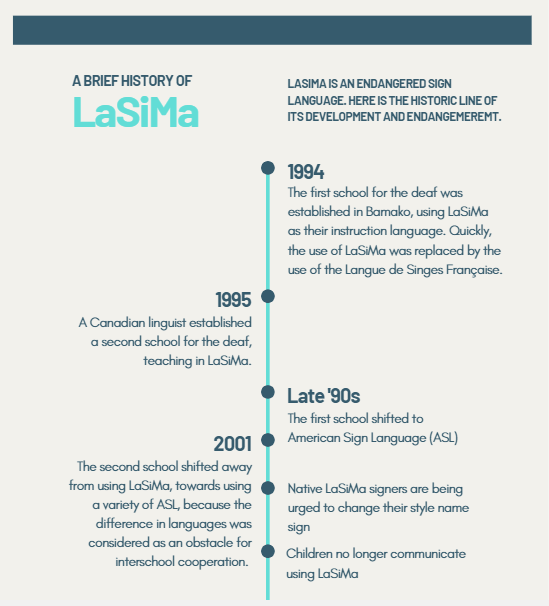
... and welcome to this blog post!
In this blog we - Pleun and Rachel - will delve deeper into the endangered Langue des Signes Malienne (LaSiMa) or (for those of you who don’t know any French) the Malian Sign Language. Yes, you read it correctly: a sign language!
This language is mostly spoken by non-educated adult, male deaf signers in Bamako, Mali, and it is considered their native language. However, as you will read in this blog, the existence and use of LaSiMa is currently under threat by the gradual shift towards the American Sign Language (ASL).
Before we will go more into detail about the origin and history of LaSiMa, its use today, and how this language illustrates the larger theme of endangered languages, we will first introduce the author of the article that our post is based upon.
Meet Dr. Victoria Nyst!
"Hello, my name is Victoria (name sign), V-I-C-T-O-R-I-A N-Y-S-T. I work at Leiden University, doing research on sign languages in Africa".
Perhaps not surprising, Dr. Nyst is a lecturer at Leiden University, specialized in sign languages, specifically in terms of their documentation and description. Apart from that, she is also interested in lexicography, linguistic iconicity, and the gesture-sign language interface. Her research mostly focuses on sign languages in Africa. This enabled us to take a closer look at one of her studies conducted in Mali, which in the end became a source of inspiration for our own analysis of endangered languages.
Langue des Signes Malienne (LaSiMa)
In 2008, Nyst published the study Documenting an Endangered Sign Language: Constructing a Corpus of Langue des Signes Malienne (LaSiMa). In this article, Nyst shares her experiences in engaging in the LaSiMa-project, which has been initiated to document and describe LaSiMa, as it faces an endangerment of its use and existence. As Nyst explains: “the project hopes that the research activities will lead to an increased interest for LaSiMa within the Malian Deaf community as well as in the wider hearing Malian society”.
This leads us to the question of why LaSiMa is currently under threat, but also why it needs to be preserved. For answers to these questions, a better understanding of the origin and evolution of LaSiMa is required. After all, from what we know by now when it comes to languages, context matters.
Let’s therefore start off with mapping the geographic area that we are talking about, followed by a historical perspective on LaSiMa.
LaSiMa: Geographical context

Here, we see the sign language map of West-Africa, in which we highlighted the Malian sign language (indicated as Mali SL), located in Bamako. Bamako is the place where the first School for the Deaf was established in 1994. In the section that follows, we will tell you more about the establishment of this school and other important events in the origin of LaSiMa.
The history and evolution of LaSiMa
Endangered languages: What do we learn?

Endangered languages do not necessarily concern spoken languages; also sign languages can be threatened in their existence. As there is a lack of knowledge about African sign languages, more research should be conducted to increase awareness about the preservation of these languages. For us, the study by Victoria Nyst on LaSiMa provides a good example of how to document and describe an endangered language.
By exemplifying how LaSiMa is embedded in Malian culture, Nyst provides another incentive for preserving this sign language. As a final example, take a look at the pictures below.
Here, the word "tomato" is captured in both LaSiMa and ASL. We see that the sign for ''tomato'' in LaSiMa reflects the cultural habit in Bamako of sqeeuzing the tomato when using it in the kitchen. Yet, the African ASL sign for ''tomato'' is the standard handsign for a ''t''. This shows that preserving language in this case also means protecting culture and cultural habits, including traditional ways of cooking. Interesting right?!
We hope you enjoyed learning more about LaSiMa, thank you for reading our post!
Sources
Nyst, V. A. S. (2008). Documenting an Endangered Sign Language: Constructing a Corpus of Langue des Signes Malienne (CLaSiMa). Proceedings Of The Lrec 2008. Retrieved from https://hdl.handle.net/1887/18521
Nyst, V. A. S. (2010). ‘Sign Language in West Africa’ in Brentari, D. (ed) Sign Languages: A Cambridge Language Survey. Cambridge University Press: Cambridge, 405-432.


